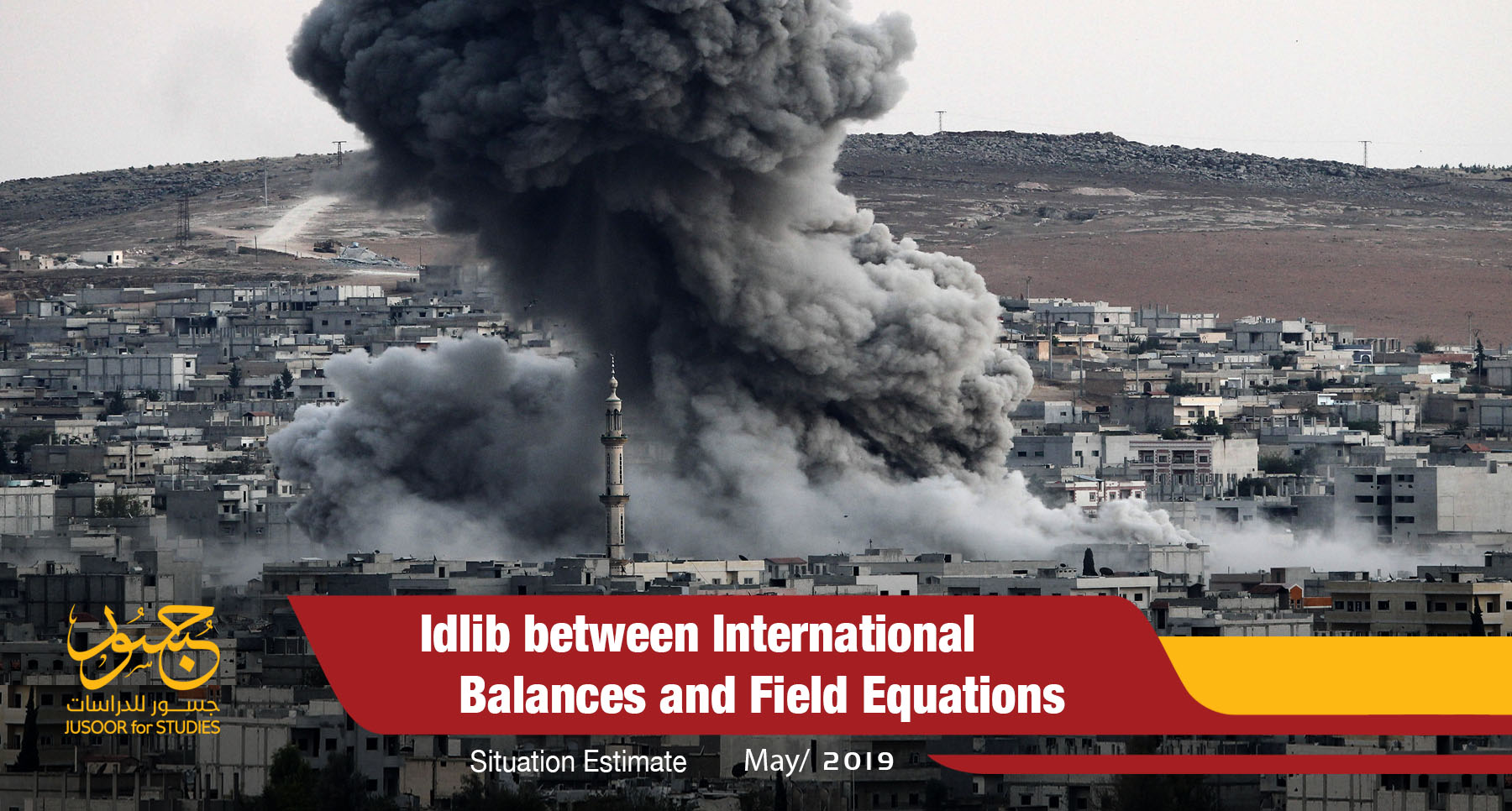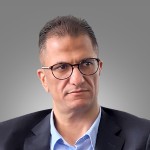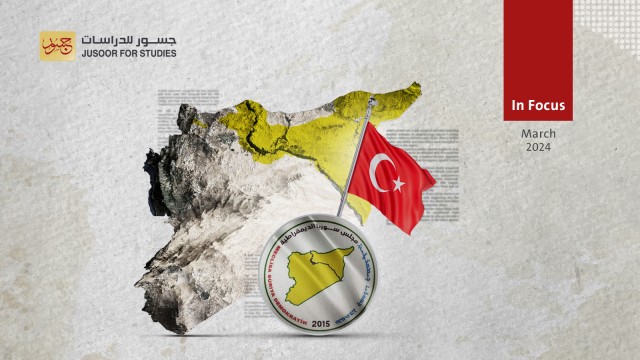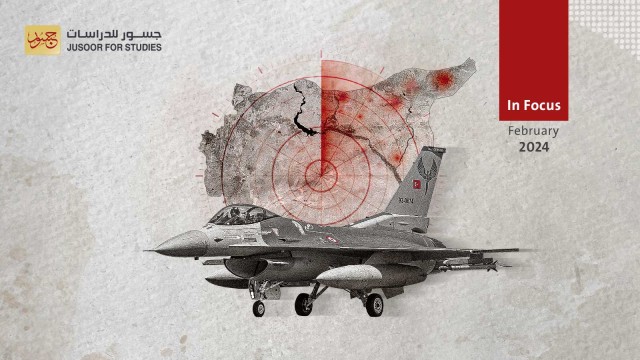Preface
On 2 May 2019, Russia and the Syrian regime launched a ground campaign incursion in the countryside of northern and western Hama. The ground campaign comes in parallel to Russian and regime aircrafts carrying out air strikes in the region which were launched prior to the start of the ground campaign.
After 11 days of fighting, the regime and Russian forces managed to gain control over 87 km2, i.e. an area around four times the size of Idlib city.
However, the regime forces’ rapid progress was short lived as a second phase of the battles began following the intervention of the National Liberation Front (NLF) factions, equipped with anti-tank missiles obtained from Turkey. This intervention bears multiple messages, both local and international, and changed the rules of the game on the ground in Idlib.
The battles for the countryside of Hama and Latakia cannot be separated from the wider political and field contexts. Russia seeks to consolidate its gains on the ground before embarking on the constitutional process, which it is expected to announce the start of soon.
This report discusses the Russian motives behind the attack on Idlib, the local and international implications of the battle, the impact of these battles on the ground and politically, and the expected future for the Idlib region and its position in the political solution.
The Areas Opposition Factions lost in Idlib and Hama in May 2019
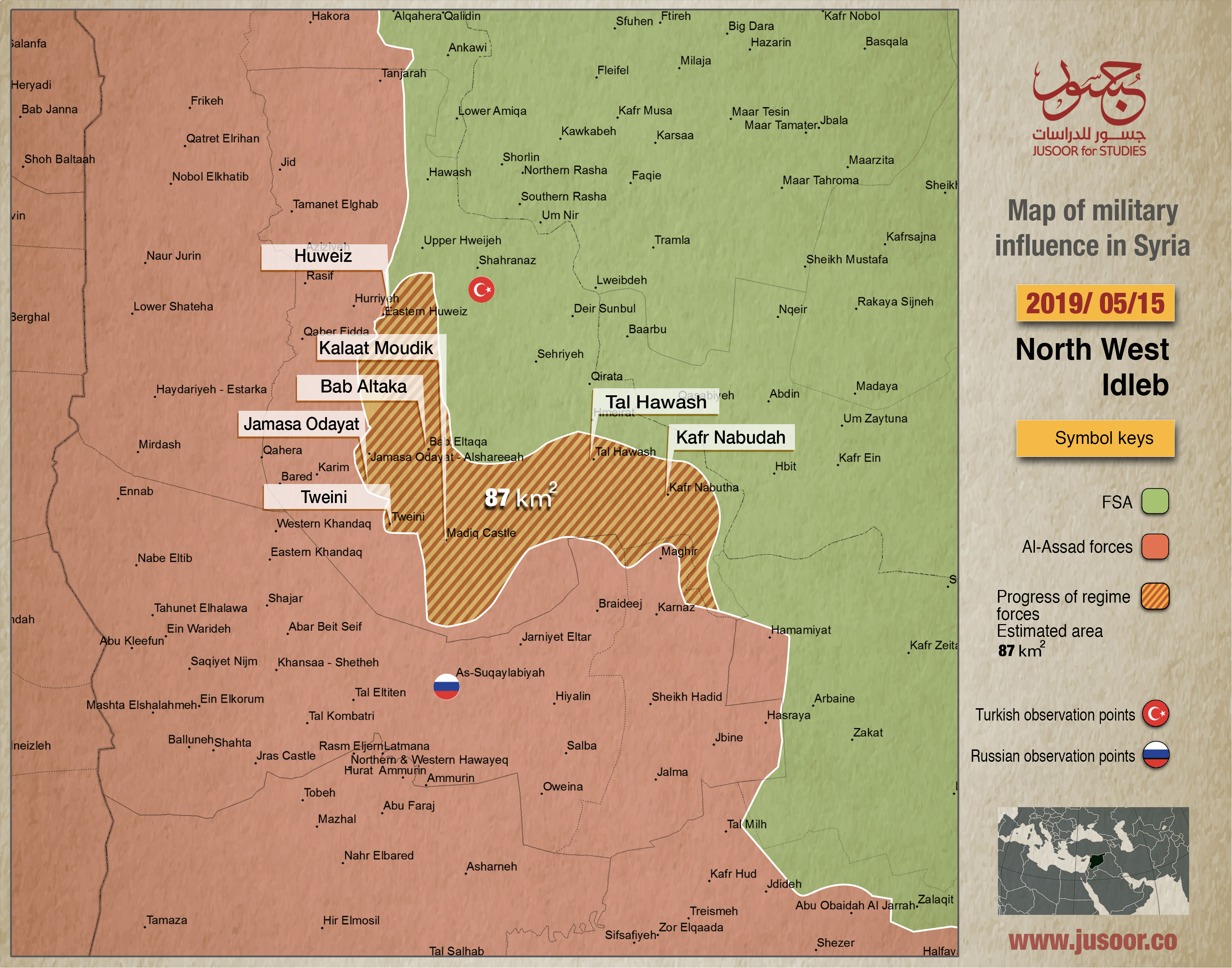
The Areas bombed in Idlib and Hama in May 2019
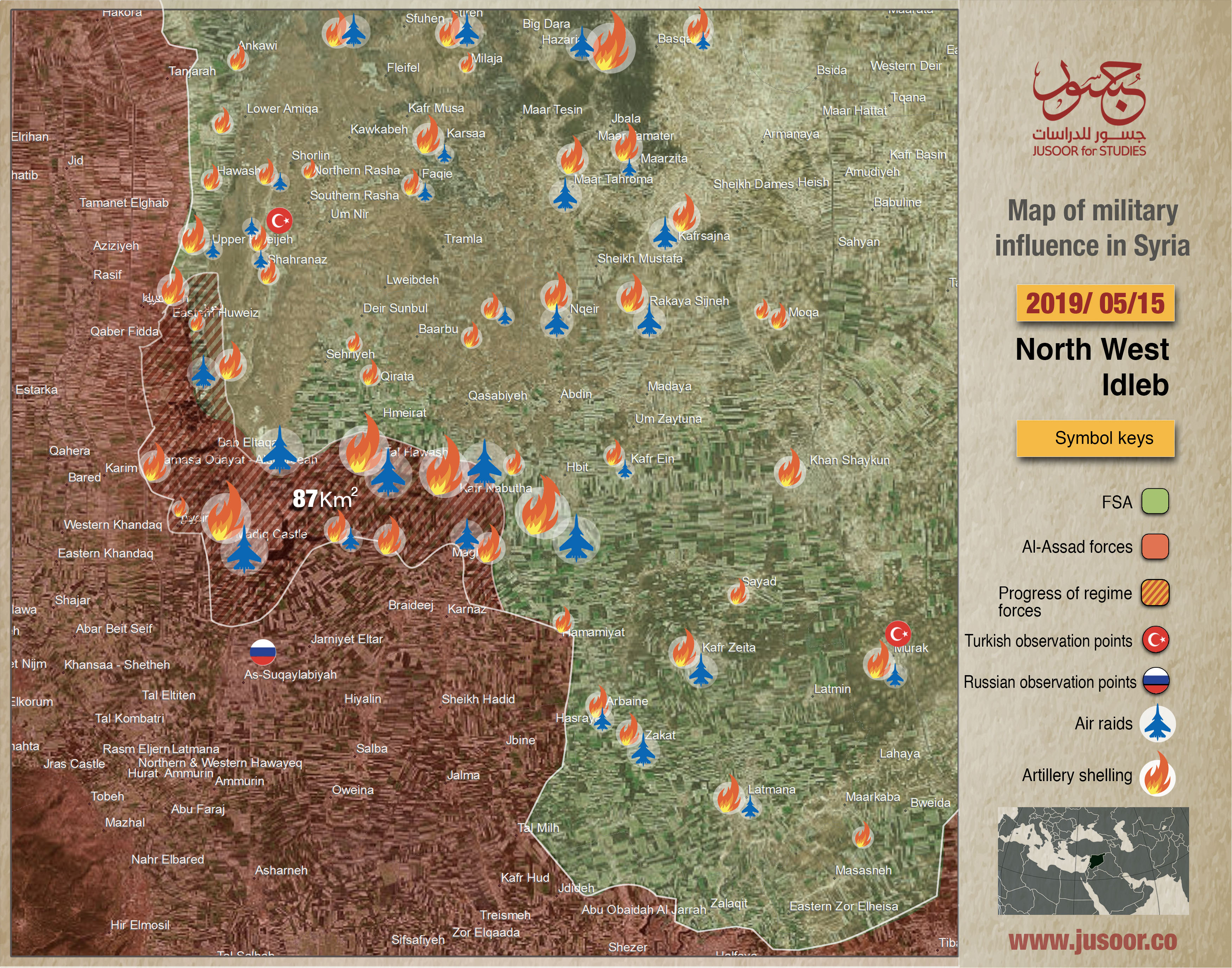
What do the aggressors want from Idlib?
The regime seeks to extend its influence over the largest area of Syria, because any additional square kilometers gained represent greater influence and control. Increased territorial control also the regime may develop greater resistance to the pressure from various actors including its allies, and that it reduces the nightmare represented in the areas outside its control, the nightmare which began at the end of 2011 and seems to be ending soon.
On the other hand, Russia is aware that the Idlib region will remain outside the control of the regime in the medium term, because it bears special symbolism. In the absence of opposition forces in Idlib, there will remain no opposition actors to conclude a political solution with.
While Russia recognizes Idlib’s symbolism and seeks to preserve it, its political and field movements with regard to Idlib are determined by a number of key objectives:
1. Protecting the Russian bases in Latakia and Tartous and stopping all attacks launched from Idlib and Latakia countryside. Russia already tried to achieve this goal by establishing demilitarized buffer zone that are free of heavy weapons, but this measure did not stop the opposition forces from launching drone and Grad rocket attacks.
2. Imposing field equations that force the actors to consent to the cessation of hostilities which will end the final military action between the various parties until a comprehensive political solution is reached.
3. Maintaining the continuity of the Astana process and adhering to the Turkish partnership in this process. Turkey’s exit from the Astana talks would indicate the end of the certainty of this process and that Russia has lost its ability to impose any future political solutions, which alone achieves Russia’s goals from the war.
It is necessary to note that during this recent campaign, Russia has not issued any hostile statements against Turkey and it persists in denying its military participation in the battle on Idlib, despite its clear involvement in the aerial bombardment campaign.
4. Committing to the international consensus with the various parties, including the United States and Europe. Due to these consensuses, Russia is forced to disregard comprehensive military options although it has the ability to impose them in the field.
The Russian Strategy in Idlib
The former variables offer Russia space to maneuver as firstly, Russia recognizes that Idlib's symbolism is related to the existence of Idlib city and its environs, and that this symbolism is not tied to the entire governorate of Idlib, the countryside of Hama, Latakia and the western Aleppo countryside which are currently areas of reduced escalation. Russia is currently seeking to gain some of these areas - soft layers of the region- which do not generally affect its relations with Turkey and the other international actors. Simultaneously, these maneuvers distance the opposition factions in the region from the Russian bases, and eliminate any possible threat on their part.
Russia will continue to try to gain areas, in the short term at least, until the work of the Constitutional Commission is launched. The soft layers of the Idlib area include the remaining parts of northern Hama countryside and Jisr al-Shughur villages.
The field pressure forces Hay’at Tahrir al-Sham (HTS) to rethink its intransigent strategy which is based on HTS’s belief that it is capable of resisting Russian attacks and preventing the regime from advancing to the areas under its control. These assumptions were discredited during recent battles.
It is possible to say that this last battle for Idlib seeks, among other things, to determine the fate of HTS rather than the fate of Idlib itself. Russia has already managed to curtail HTS, shattering its image before its audience and before local and international actors. The curtailment prompted HTS to launch a propaganda campaign to justify its defeat, and to encourage the Liberation party in Idlib to organize a campaign whereby placing the responsibility of this defeat on the Turkish side alone.
As part of this strategy, Russia is trying to end the ability of any of the factions in the Idlib region to destabilize the area at this stage especially as this stage will be followed by the launch of the constitutional committee and even the agreement on a political solution. The battles must occur at this stage as conducting battles during the next phases will tarnish the political solution and weaken the Russian plan to impose stability before the initiating the constitutional and electoral processes.
Indicators of Recent Battles
The recent battles in Hama countryside have many indicators on the field and political levels. The impact of the battle goes beyond the boundaries of the towns where the fighting is occurring to determine the form of the relationship between the guarantor states on the one hand and the actors in Idlib on the other.
The most significant indicators can be summarized as follows:
1. The NLF factions’ intervention, armed with qualitative weapons from Turkey, demonstrated that there was no deal between Ankara and Moscow regarding the attack, and that Turkey does not shy away from taking a position, but within the legal and political margins available.
2. The attack and its details reversed the existing margins of the de-escalation agreement between Turkey and Russia. Russia is aware that the attempt to take control of some of the loosely controlled areas in the de-escalation zone will not affect the content of the strategic agreement between the two countries. Simultaneously, Turkey has the margin to provide the fighters its supports with weapons that can result in the attackers incurring heavy losses and stopping their progress. The attack does not mean an end of the de-escalation agreement and nor the end of the Astana process.
3. In parallel with the heavy losses incurred by HTS in the areas under its influence in northern Hama countryside, and its modest performance in the fighting, the NLF factions emerged as a real force capable of stopping the advance of the regime’s forces. These events will have a major impact on the internal equations in Idlib as well as affecting the guarantors of the Astana process. Russia insists that HTS controls Idlib in full, but on the ground, the NLF stopped the Russian attack while the areas under HTS control collapsed quickly.
4. The regime forces sought to provoke the Turkish guarantor to the maximum extent possible by targeting the perimeter of Turkey’s observation posts in Syria with artillery bombardment. In the first incident of its kind since the establishment of the observation posts, the attacks resulted in the injury of two Turkish soldiers. Turkey has exercised restraint and avoided complicating the scene dramatically. Instead, Turkey chose to provide the factions it supports with weapons that could inflict heavy losses on the regime and halt its full offensive.
5. The battles have shown that air strike cannot conclude the battle for Idlib, neither now nor in the future, and that the use of ground force to gain full control of the province - though not an option for Russia - would be costly and the Russian-backed forces are unable to do so. The battle requires ideological fighters who are only available in the Iranian camp.
Summary
The battles that began in May 2019 in the countryside of Hama and later in the countryside of Latakia have field and political implications that transcend the geographic areas of the clashes. The battles influence the balance of power in Idlib, the relationship between the guarantors of the Astana process and even the political solution process itself.
Apparently, through the battles, Russia aims to gain control of some areas in Idlib which do not affect Idlib’s strategic location. Russia agrees with the other actors involved that Idlib should remain under the control of the opposition, and recognizes that its full return to regime control is delayed until the political solution stage.
The most significant indication from the battle was the denial of any Russian-Turkish agreement to target Idlib which is an idea promoted by several parties in Idlib especially HTS. This rumor gained momentum outside Syria and its circulation was aided by the lack of a Turkish public response during the first week of the battle, and later, Turkey’s limited reference to the issue despite the bombing around the Turkish observation posts.
The battle also showed HTS’s weak military performance which will influence local and international actors’ assessment of the faction. Based on the indicators from the battles in Hama’s countryside, it seems that HTS must reconsider its entire system of internal and external relations with the remaining military and civilian parties in Idlib. It is also necessary for HTS to abandon its policy of hegemony and monopoly, and deal with the political indicators based on its actual military abilities as revealed by the battles rather than its ability to eradicate the remaining factions in the region.



